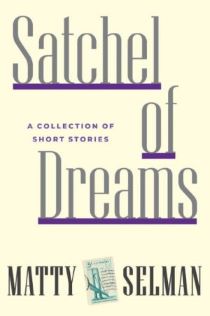Perusing a fellow Staten Islander’s Satchel of Dreams.

One of the consequences of being from Staten Island — in addition to the blank looks from people if I mention that’s where I grew up — is my need to read anything written about it.
We Islanders have played a modest role in shaping popular culture, for good and for ill. We gave you Christina Aguilera, Wu-Tang Clan, Colin Jost, and even Pete Davidson. But a strong literary voice? Not yet.
Finally, though, Staten Island receives its literary due in Matty Selman’s memoir in episodes, Satchel of Dreams: A Collection of Short Stories. The dreams are sometimes nightmares, including this one from the 1950s. A nurse leads 7-year-old Matty to his hospital room to await surgery the next morning:
“We turn and walk down a long, dimly lit hallway that echoes our every step; suddenly filled with a terrifying, unescapable banging, followed by intermittent hissing; steam escaping a radiator? I cannot imagine the monster I am about to face.
“We walk past a room, unlike anything I’ve ever seen. A wall of steel with round portholes and glass pressure gauges. Sticking out of each porthole is a child’s head. The sound is deafening. Some turn to me as I follow Mrs. McCarthy.
“‘Do not stare at the children in the iron lungs. You wouldn’t want them staring at you, would you?’
“‘No, ma’am.’”
You may think nothing more terrifying could happen to a kid on his first trip to a hospital, but it does.
I should disclose what might be clear already: Matty and I are the same age. We went to the same junior high school and knew each other, though not well. That’s why I use his first name here. I’ve only seen him once since high school, but it’s weird to refer to him as “Selman.” (I tried it.)
My strongest recollection of Matty back then is when we performed in a ninth-grade production of “Witness for the Prosecution,” a show that must have been indescribable agony for our audience of close relatives to sit through. During dress rehearsal of a pivotal scene, as my character cross-examined Matty’s character, I had an unsettling thought: While Matty was acting, I was reciting my lines.
Matty went on to New York’s famous High School of Performing Arts (of “Fame” fame) and a distinguished career as a composer and playwright. But he chose to write this book about his childhood, his family, and, you know, the Island.
With wry humor, Matty has paid attention to his world. He defines each era by the used car his father was driving. The remarkable people he has loved and lost and remembers are all here, in three dimensions.
There’s his passionate mother, a leader in the Montessori School movement who did pushups in parking lots on breaks from long drives. His father, superficially an Everyman, spent weekends hauling his children to odd corners of New York City on the hunt for interesting people, wonderful food, and decayed contraptions he might revive.
There are sad moments. The death of a relative spoils the song “Go Tell Aunt Rhody” when Matty realizes what the lyrics actually describe. There are laugh-out-loud moments, too, like the catering breakthrough at Matty’s bar mitzvah, when the reader looks around for someone to share the passage with, only to realize, on an airplane, That Sort of Thing Just Isn’t Done.
And everyone has a relative, or at least an in-law, who answers Matty’s fond description of these two:
“The availability of free street parking dictated when I would get to see my father and uncle. Usually, that meant after 11 a.m. on weekdays and Saturdays, and any time on Sundays. The brothers never fed a meter. It was not in their DNA.”
I opened Satchel of Dreams expecting a Staten Island book. I found much more.
David O. Stewart is the author of four novels and five works of history. The Burning Land, Book Two of his Overstreet Saga trilogy, will release on April 4, 2023.

